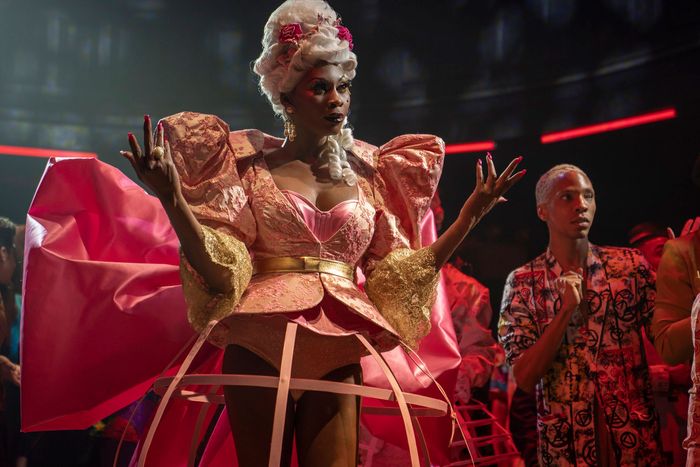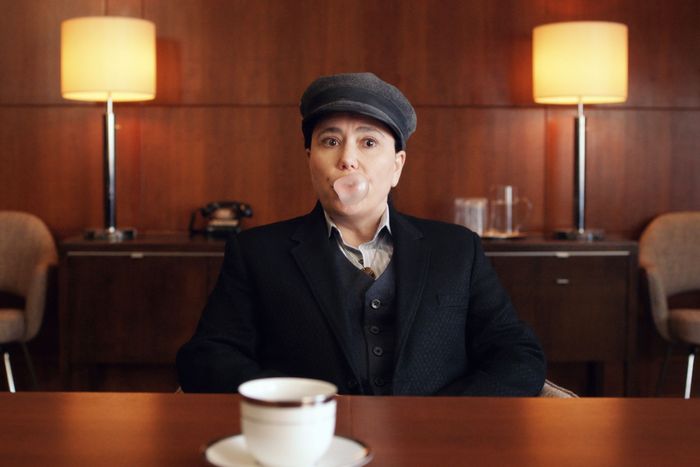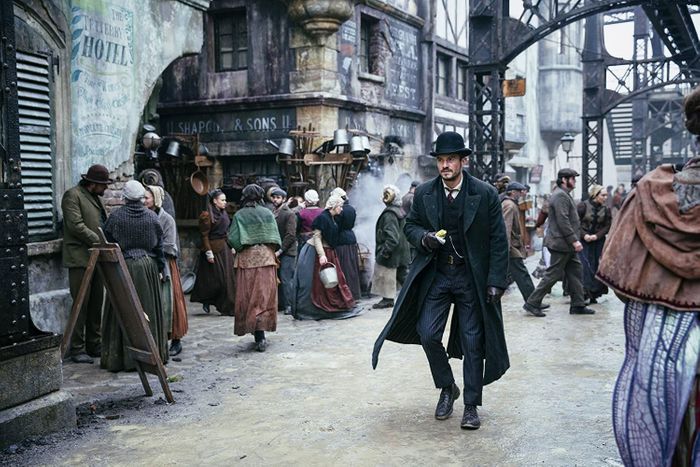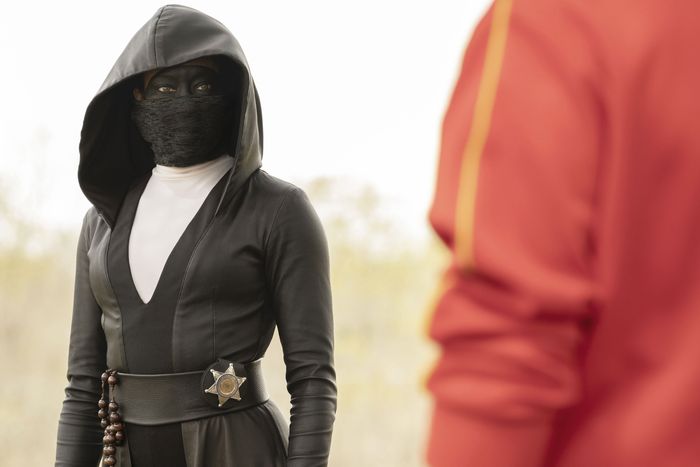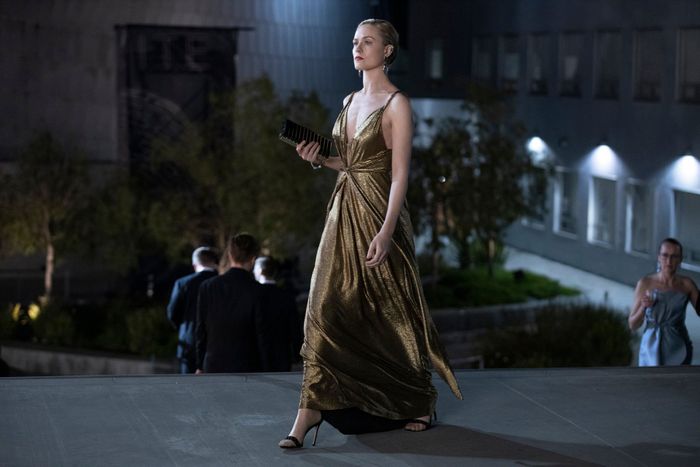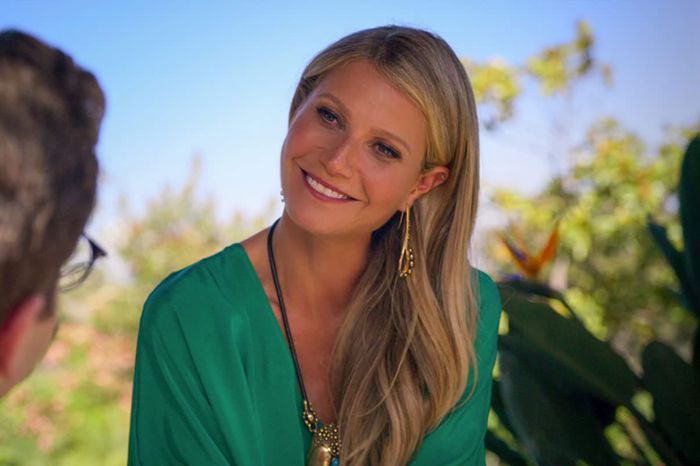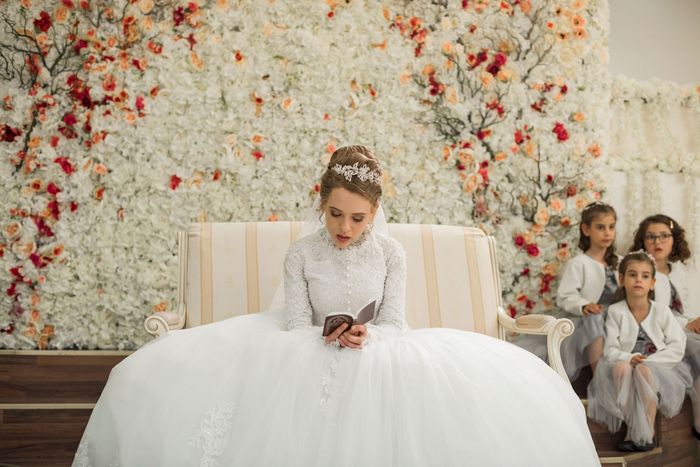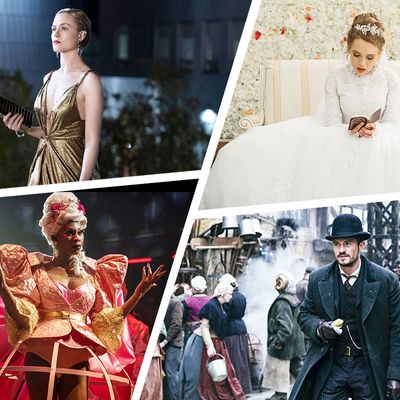
“We’re not just seamstresses and tailors, we’re engineers and architects.”
Although Emmy awards for costuming are typically bestowed to a show’s designers, supervisors, or a combination of the two, much of the actual day-to-day work of costuming a series falls to a larger team helping to bring those people’s visions to life. One integral member of these teams is the pattern-maker or tailor, the person responsible for constructing the clothes as well as ensuring that every garment fits properly. Tailors and pattern makers, also called cutters or drapers, tend to have very close relationships with their designers, but their contributions often go unseen by their very nature — as Carnival Row principal cutter Karen Francis Smith puts it, “My role is to realize [the designer’s] vision, not to produce my own.”
At the same time, “Tailoring is often underestimated,” says Unorthodox tailor Matthieu Niemeier. “People in general think, Oh, yeah, sewing a piece of cloth together, there’s not much work in that. But there is a large amount of patterning that needs to be done. I try to explain that I have to make fabric that is flat into something that fits on a body, and it’s really architectural.”
Most costume departments have a rack (or racks) where clothing that requires alterations is hung. Each garment is marked with a tag that includes the actor and character names, the scene it will be worn in, what day that scene is supposed to film, and any alteration notes. Even store-bought, contemporary clothing can require alterations; it’s not uncommon for a film and television tailor to shorten the hem of a T-shirt, add darts to the back of a men’s dress shirt, take in the waist of a pair of pants (or five), or completely take apart a garment, recut it, and put it back together, all in the same day. Additionally, actors often have more than one of the same costume — especially if they wear the same thing for an entire episode or if there are stunts — but multiples are not always purchased at the same time, so a tailor might need to duplicate changes on a garment without having the original one (because it’s either currently on the actor or on a truck on the other side of the city).
“In film and TV, you have to be able to sort of be like water,” says Andrea Wheeler, a cutter/fitter for Westworld. “People tell me I’m easygoing for a tailor because I have no problem saying, ‘Oh, you need me to literally drop this garment that I’m right in the middle of doing and run over there and do something else. Okay.’ Not everyone can do that.”
The only real rule when it comes to working in TV and film is that things can and probably will change; every show presents its own set of challenges and problems to solve, and that extends all the way through to the hems, darts, and inseams on the costumes. So we asked some of the tailors and pattern-makers who contributed to some of this year’s Emmy-nominated series to share some of their biggest, most rewarding costuming challenges.
Pose
Yvette Helin, Head Tailor
On Pose we get to build a lot, and the builds are fantastical. We make something that in the show they would have made from scratch or found, usually for the wild ball scenes. So they’re not necessarily based on anything anyone’s seen or done before, and that’s really fun for us. We spend a lot of time with our designer [Analucia McGorty] working out the details of her unique designs.
The carousel dress — technically it’s the Marie Antoinette outfit that Ana designed for Dominique [Jackson], who plays Elektra — Jen [Hebner, my second] and I built it together. I made it from the waist down and she from the waist up. The dress bottom consisted of a metal frame with a spinning horse carousel. Ana told me she dreamed of this dress. She showed me a picture that inspired the idea of the carousel. That was an interesting project, trying to find all the right parts. I have to credit my friend and tailor Alice Bee for pointing me to a source she found on eBay after I mentioned a part I was hunting for to realize the spin of the carousel.
In the scene, the actress gets her head chopped off in a guillotine. It’s a gag; we’re not supposed to see blood, and her head doesn’t really get chopped off, obviously, but it’s supposed to be a representation of that. After much head-scratching, we called upon Ted Southern, who’s a mechanical genius, to help fabricate a mechanism to incorporate into the outfit that would extend up and shoot the bodice above the actress’s head in a quick second. We were very excited when it worked successfully in rehearsals and all the things that Ana wanted happened. We made them happen as a team. And it was awesome.
The Marvelous Mrs. Maisel
Daniel Weger, Key Tailor
I patterned and tailored all of Susie’s [Alex Borstein] looks. The two-piece suiting was new for last season. I made multiple options, going straight to fabric without first fittings so that she could try on finished pieces with Donna [Zakowska] to see how everything worked with the rest of her wardrobe.
My biggest challenges [on Maisel] were usually because of oddly shaped background actors. Because it’s a period show, you can’t just run out to the store and pick something up. There aren’t a lot of vintage offerings for people with nonstandard sizing requirements so we’d often have to make things from scratch very quickly. Working on the show was a very collaborative experience; for instance, everyone was involved in the Cuban-dancer costumes: designers, shoppers, painters, everyone.
Carnival Row
Karen Frances Smith, Principal Cutter
Carnival Row was challenging because of the different creatures [in the show]. We weren’t always building to dress a normal human shape. One that sticks out is creating perfect tailored garments for Agreus, whose fawn legs and posture meant that nothing sat the way it should, but who had to look the perfect Victorian gent.
I’m most happy with how Philo’s (Orlando Bloom’s) suit and coat came out. I was lucky we had a tailor experienced in hand-tailoring on the team. That, along with my period cutting background, made the whole process a lot easier. I believe Orlando was happy with the result, too, as he said on his Instagram page that we were better than Savile Row. You can imagine how chuffed I was.
My job is so much more than just cutting a pattern and deciding how to construct a garment; it involves communicating with people, interpreting ideas, thinking outside the box, conducting in-depth research, as well as an understanding of fabrics and different construction techniques, and the ability to bring together many different threads to meet an often challenging deadline. No cutter on a project this size works alone, and a great team makes the job infinitely more satisfying.
Watchmen
Jared Leese, Head Tailor
This show was huge. We had three different units and four wardrobe trucks, plus a unit shooting the Jeremy Irons stuff in Wales. [Jeremy] Irons’s costumes were made in L.A. using a 3-D body cast of him, then brought to Atlanta where we were filming so Meghan [Kasperlik] could see everything. So many things happened [during filming] that no one could have seen coming, like the Sister Night leather hood stretching out under the hot lights. There were 10 or 12 hoods, and we took them all apart, flatlined them with neoprene, and buried magnets into the wig cap and hood to keep them in place.
Sister Night had three different versions of her costume and two of each version. One had neoprene padding at the elbows, knees, and hips; one was action-oriented with extra gussets of spandex hidden; and the third was the pristine, just standing around talking, version. Then her stunt double had two each of two of the versions.
Westworld
Andrea Wheeler, Cutter/Fitter
One of my favorite costumes [from last season] was the gold transforming dress, which I did not engineer. Lydia Jakubowski came up with the mechanics of it. What she ended up doing was actually quite simple: two dresses connected at the waist. Which dress was visible was determined by how we folded it and how it snapped into the top. That was really fun, seeing something that looked super complicated end up being simple, clever engineering.
Another of my favorites — probably because it was such a haywire moment — was the samurai outfit, the armored costume. That outfit was redesigned on a Friday afternoon, and it was first up three hours away on Monday morning. Six of us worked through the entire weekend. That was a situation in which we didn’t even know if they were going to have a costume on Monday. Initially they wanted eight (for doubles and stunts) and we were like, “You’ll be lucky if you get two.”
The Politician
Ruth Stockl, Alterations Fitter
My days [on The Politician] were split between taking a full set of measurements for new cast members, popping in and out of fittings as needed, and buzzing through a bunch of alterations and builds as they got approved. We shared a big warehouse on a studio lot, which was great, as I got to be with the rest of the team for once (often I am in a janitor’s closet, balancing on the back of a truck, or in a spooky basement). [In film and TV] there are always instances of panicked last-minute work due to the approval process having to go through people who are producing many more than one show at a time.
One particular silk chiffon caftan I made for Georgina [Gwyneth Paltrow] took hours to cut because it was like working with smoke. The green caftan I made her sticks with me as a great example of how such a simple garment can be so beautiful when made in the right fabric.
Unorthodox
Matthieu Niemeier, Tailor
My day [on Unorthodox] always began with a meeting with Justine [Seymour] where we’d go over the day. When there weren’t fittings, I worked on whichever costumes were more important depending on the schedule. All the costumes for the show were really interesting, especially because of all the rules of how to dress [as a part of the Hasidic Jewish community], and what had to be worn on what day.
I spent a lot of time on Esty’s wedding dress. The wedding dress was a challenge because we had to capture visually the idea of what the dress symbolized in Esty’s journey. We had to create a garment that was not only beautiful but also represented Esty’s emotional state. Plus, Shira [Haas] had to be able to move because she had a long day of dance scenes while wearing it. All of that took a lot of time and thought.


